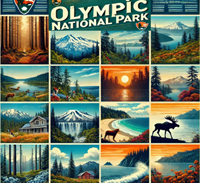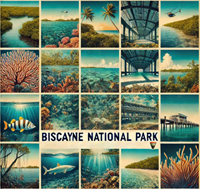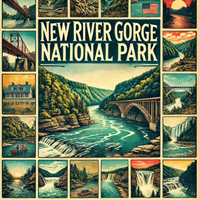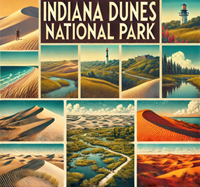

Embark on a journey curated by seasoned explorers William and Hui Cha Stanek, who have spent decades immersing themselves in the diverse landscapes of North America. These itineraries are more than just travel plans - they are thoughtfully crafted adventures designed to help you connect with the natural world, discover hidden gems, and create lasting memories.
National Parks Index | US Itineraries Index | American Roadtrips Index

Bring home a Bugville Critters book and watch as your child's love for reading and learning grows with every page. Hand-painted illustrations bring the heartwarming stories to life. Ask your librarian to add Bugville Critters to the library's digital collection today!
Discover William Stanek's Exclusive Art Collection
Explore and purchase the stunning art featured on this site. Own a piece of William Stanek's unique and captivating artwork today!
(May 2, 2025) Unveiling the Wonders of Canyonlands and Arches National Parks: Utah's Iconic Red Rock Landscape. 2-Day Itinerary.
Introduction: Embark on an Adventure Through Utah's Red Rock Wonderland
There's something otherworldly about the red rock landscapes of Utah. The way the sunlight dances across the sandstone, casting deep shadows and illuminating the vivid hues of red, orange, and gold, makes you feel as if you've stepped into a different world. For Hui Cha and me, Canyonlands National Park and Arches National Park represent the epitome of this beauty – a place where the forces of nature have sculpted the earth into a vast, rugged wilderness that is both humbling and awe-inspiring.
Our journey began on a warm summer morning as we drove along the winding roads that lead to these two iconic parks. The desert stretched out before us, a sea of sagebrush and juniper trees, with the distant silhouette of the La Sal Mountains providing a dramatic backdrop. We had been to Utah's red rock country before, but the sense of anticipation was still palpable. These parks have a way of drawing you in, of making you feel small in the best possible way.
Canyonlands National Park, with its sprawling vistas and deep canyons, is a place where time seems to stand still. The park is divided into three districts – Island in the Sky, The Needles, and The Maze – each offering a unique perspective on this ancient landscape. As we stood on the edge of the Island in the Sky, looking out over the labyrinth of canyons and mesas, we were struck by the sheer scale of it all. It's a landscape that defies comprehension, a reminder of the immense power of the forces that shaped this land.
A short drive away, Arches National Park offers a different kind of beauty. Here, the landscape is dotted with more than 2,000 natural stone arches, each one a testament to the relentless forces of erosion that have sculpted this land over millions of years. As we hiked through the park, we marveled at the delicate balance of these arches, some of which seem to defy gravity as they perch precariously on narrow spires of rock.
Join us as we take you on a journey through these two remarkable parks – Canyonlands and Arches. We'll share our stories, tips, and insights to help you create your own unforgettable experiences in Utah's majestic red rock wilderness.
Day 1: The Vastness of Canyonlands National Park
Morning: Sunrise at Mesa Arch
Overview
Start your Canyonlands adventure with a sunrise at Mesa Arch, one of the park's most iconic locations. Perched on the edge of a cliff in the Island in the Sky district, this natural stone arch frames the rugged landscape below, with the distant La Sal Mountains providing a stunning backdrop.
Tips from William
"Arrive at Mesa Arch by 5:30 AM to secure a spot for the sunrise. The early morning light is magical, casting a warm glow on the underside of the arch and illuminating the canyons below. Bring a wide-angle lens to capture the full scene, and a graduated neutral density filter to balance the exposure between the bright sky and the darker foreground."
Insights from Hui Cha
"Mesa Arch at sunrise is a truly magical experience. The way the light filters through the arch and bathes the landscape in a golden glow is something you won't forget. Dress warmly, as it can be quite chilly before the sun rises, and bring a thermos of hot coffee or tea to enjoy while you wait for the show to begin."
How to Access Mesa Arch
Directions:
- From Moab, take US-191 north for about 10 miles, then turn left onto UT-313 and follow the signs to Canyonlands National Park's Island in the Sky district. The Mesa Arch trailhead is about 6 miles from the park entrance.
Trail Details:
- Trail Length: 0.5 miles round-trip
- Elevation Gain: Minimal
- Difficulty: Easy
Photography Tips: For the best shots, position yourself close to the arch, using it as a frame for the landscape below. Use a small aperture (f/16 or smaller) to keep both the arch and the background in focus. If you're lucky, you might even catch a glimpse of the sun rising directly through the arch, creating a dramatic silhouette.
Alternative Activity: If the early morning start at Mesa Arch is too demanding, consider watching the sunrise from the Grand View Point Overlook. This viewpoint offers expansive views of the canyons and mesas, and while it's less crowded than Mesa Arch, it's equally stunning at dawn.
Mid-Morning: Hiking the Grand View Point Trail
Overview
After the sunrise, continue your exploration of the Island in the Sky district with a hike along the Grand View Point Trail. This easy, 2-mile round-trip hike takes you along the edge of the mesa, offering breathtaking views of the canyons, cliffs, and distant mountains.
Tips from William
"The Grand View Point Trail is one of the best ways to experience the vastness of Canyonlands. Bring a wide-angle lens to capture the expansive vistas, but also keep a telephoto lens handy for zooming in on the details of the canyon walls and rock formations. The morning light is ideal for photography, so take your time and enjoy the walk."
Insights from Hui Cha
"This trail offers some of the most spectacular views in the park, and it's relatively easy, making it perfect for all skill levels. I love finding a quiet spot along the trail to sit and take in the scenery – the sense of solitude and peace here is truly special."
How to Access the Grand View Point Trail
Directions:
- The trailhead is located at the end of the Island in the Sky road, about 12 miles from the park entrance.
Trail Details:
- Trail Length: 2 miles round-trip
- Elevation Gain: Minimal
- Difficulty: Easy
Photography Tips: As you hike along the trail, look for opportunities to capture the contrast between the red rock formations and the deep blue sky. Use a polarizing filter to enhance the colors and reduce glare. For a more creative shot, try framing the canyons with the desert plants that line the trail.
Alternative Activity: If you prefer a shorter hike, consider exploring the nearby White Rim Overlook Trail, a 1.8-mile round-trip hike that offers stunning views of the White Rim Road and the Colorado River below. The trail is relatively flat and easy, making it a great alternative for those seeking a less strenuous hike.
Afternoon: Exploring the Shafer Canyon Road and the White Rim Road
Overview
In the afternoon, take a drive down Shafer Canyon Road, a steep, winding dirt road that descends into the heart of Canyonlands. The road eventually connects with the White Rim Road, a 100-mile loop that offers some of the most remote and stunning scenery in the park.
Tips from William
"Shafer Canyon Road is not for the faint of heart – it's narrow, steep, and often has sheer drop-offs, so drive carefully. The views, however, are well worth it. Bring a wide-angle lens to capture the dramatic landscapes, and a telephoto lens to zoom in on the details of the canyons and rock formations. If you're planning to explore the White Rim Road, make sure you have a high-clearance 4WD vehicle and plenty of supplies."
Insights from Hui Cha
"This drive is an adventure in itself, offering a completely different perspective on the park. The views from the bottom of the canyon are incredible, and the sense of isolation is profound. Be sure to check the road conditions before you go, as it can be impassable after rain."
How to Access Shafer Canyon Road
Directions:
- From the Grand View Point Overlook, backtrack on Island in the Sky Road and turn left onto Shafer Canyon Road. The road descends steeply into the canyon, eventually connecting with the White Rim Road.
Road Details:
- Road Length: 5 miles to the junction with White Rim Road
- Elevation Gain: Steep descent
- Difficulty: Difficult (4WD recommended)
Photography Tips: Stop frequently along the road to capture the changing views as you descend into the canyon. Use a wide-angle lens to capture the dramatic drop-offs and the winding road below. For a more detailed shot, use a telephoto lens to zoom in on the rock formations and the textures of the canyon walls.
Alternative Activity: If you prefer to stay on paved roads, consider exploring the scenic drive along Island in the Sky Road. This 34-mile round-trip drive offers stunning views of the surrounding canyons and mesas, with several overlooks and short hikes along the way.
Evening: Sunset at Green River Overlook
Overview
End your day with a visit to the Green River Overlook, one of the most spectacular viewpoints in Canyonlands National Park. As the sun sets, the landscape below is bathed in warm, golden light, highlighting the intricate patterns of the canyons and the winding course of the Green River.
Tips from William
"Green River Overlook is a fantastic spot to capture the sunset, with wide, sweeping views of the canyons and the river below. Set up your tripod well before sunset to find the best angle and use a wide-angle lens to capture the full scene. A graduated neutral density filter will help balance the exposure between the bright sky and the darker landscape."
Insights from Hui Cha
"Sunset at Green River Overlook is an experience you'll never forget. The way the light plays across the canyons, casting long shadows and turning the rock a deep red, is truly magical. Bring a blanket and a warm drink, and take some time to simply sit and enjoy the moment."
How to Access Green River Overlook
Directions:
- From the Island in the Sky Visitor Center, follow the main road for about 6 miles, then turn left onto the road to Green River Overlook.
Overlook Details:
- Location: About 6 miles from the Island in the Sky Visitor Center
- Elevation Gain: None (overlook is accessible by car)
- Difficulty: Easy
Photography Tips: For a stunning sunset shot, position yourself on the western edge of the overlook to capture the last light of the day as it illuminates the canyons below. Use a small aperture (f/16 or smaller) to keep the entire scene in focus, and experiment with different shutter speeds to capture the changing light. If the conditions are right, consider staying after sunset to photograph the stars as they appear.
Alternative Activity: If you prefer a less crowded spot for sunset, consider visiting the nearby Orange Cliffs Overlook, located just a short drive from the Green River Overlook. The views are equally stunning, with the added bonus of being less crowded.
Conclusion: Reflections on the Day
As the last rays of sunlight faded from the sky and the stars began to emerge, Hui Cha and I stood quietly at Green River Overlook, reflecting on the incredible journey we had just experienced. From the breathtaking sunrise at Mesa Arch to the peaceful sunset over the Green River, each moment had been a reminder of the sheer power and beauty of Canyonlands National Park.
These moments, spent in the heart of nature, are what make our travels so meaningful. They're a reminder of the importance of preserving these wild places, and of the deep connection we feel to the land. As we packed up our gear and prepared to head back to our campsite, I felt a deep sense of gratitude for the day's experiences and for the time spent in this incredible park.
Our journey through Utah's red rock wilderness was far from over. Tomorrow would take us to Arches National Park, where we would explore a landscape of delicate stone arches, towering spires, and hidden canyons. But for now, we were content to sit beneath the stars, listening to the quiet of the desert and feeling the peace that only comes from being in the heart of the wilderness.
Day 2: The Sculpted Beauty of Arches National Park
Morning: Sunrise at Delicate Arch
Overview
Begin your day in Arches National Park with a sunrise at Delicate Arch, the most famous of the park's more than 2,000 stone arches. This iconic landmark, standing alone in the desert, is a must-see for any visitor to the park.
Tips from William
"Arrive at the Delicate Arch trailhead by 5:00 AM to give yourself plenty of time to hike to the arch and set up before sunrise. The hike is 3 miles round-trip with a moderate elevation gain, so be prepared for a bit of a workout. Bring a wide-angle lens to capture the full scene, and a polarizing filter to enhance the colors of the arch and the surrounding landscape."
Insights from Hui Cha
"There's something almost surreal about standing beneath Delicate Arch as the sun rises. The way the light hits the arch, turning it a brilliant orange against the deep blue sky, is something you'll never forget. The hike is challenging, but the reward is more than worth it. Dress warmly, as it can be quite cold before the sun comes up."
How to Access Delicate Arch
Directions:
- From Moab, take US-191 north for about 5 miles, then turn right onto Arches Entrance Road and follow the signs to the Delicate Arch trailhead.
Trail Details:
- Trail Length: 3 miles round-trip
- Elevation Gain: 480 feet
- Difficulty: Moderate
Photography Tips: For the best shots of Delicate Arch, position yourself on the eastern side of the arch to capture the first light of the day as it illuminates the stone. Use a small aperture (f/16 or smaller) to keep the arch and the background in focus, and experiment with different compositions to capture the arch from various angles.
Alternative Activity: If the hike to Delicate Arch is too challenging, consider visiting the nearby Lower Delicate Arch Viewpoint. This short, easy trail offers a distant view of the arch without the strenuous climb, making it a great alternative for those seeking a less demanding experience.
Mid-Morning: Hiking the Devil's Garden Trail
Overview
After watching the sunrise at Delicate Arch, head to the Devil's Garden area, home to some of the park's most impressive arches and rock formations. The Devil's Garden Trail is one of the most popular hikes in the park, offering access to several stunning arches, including Landscape Arch, the longest natural arch in the world.
Tips from William
"The Devil's Garden Trail is a 7.2-mile round-trip hike with several optional side trails leading to different arches. Bring plenty of water and wear sturdy shoes, as the trail can be rocky and uneven in places. A wide-angle lens is essential for capturing the full scale of the arches, but also keep a telephoto lens handy for zooming in on the details of the rock formations."
Insights from Hui Cha
"This hike is one of the highlights of Arches National Park. The scenery is absolutely breathtaking, with the trail winding through narrow canyons and along towering rock fins. Take your time and explore the side trails – each one leads to a unique and beautiful arch. My favorite is Landscape Arch, which seems almost impossibly thin and delicate."
How to Access the Devil's Garden Trail
Directions:
- The trailhead is located at the end of the main park road, about 18 miles from the park entrance.
Trail Details:
- Trail Length: 7.2 miles round-trip (including side trails)
- Elevation Gain: 400 feet
- Difficulty: Moderate to Difficult
Photography Tips: For the best shots of Landscape Arch, arrive early to catch the morning light as it illuminates the arch. Use a wide-angle lens to capture the full scene, and a polarizing filter to enhance the colors and reduce glare. If you're feeling adventurous, continue along the trail to Double O Arch, where you can photograph two arches stacked on top of each other – a rare and beautiful sight.
Alternative Activity: If the Devil's Garden Trail is too long or challenging, consider exploring the Windows Section of the park, where you can see several impressive arches, including the North and South Windows and Turret Arch. The trails in this area are shorter and easier, making it a great alternative for those seeking a less strenuous hike.
Afternoon: Exploring the Fiery Furnace
Overview
In the afternoon, take a guided tour of the Fiery Furnace, a maze-like area of narrow canyons and towering rock fins that offers one of the most unique experiences in the park. Due to the complexity of the terrain, it's recommended to join a ranger-led tour, which will help you navigate the area safely.
Tips from William
"The Fiery Furnace is unlike any other part of the park – it's a labyrinth of rock that's both challenging and exhilarating to explore. Bring a wide-angle lens to capture the narrow canyons and towering walls, but also keep a telephoto lens handy for zooming in on the details of the rock formations. The light can be tricky in the canyons, so be prepared to adjust your settings frequently."
Insights from Hui Cha
"Exploring the Fiery Furnace is like stepping into another world. The narrow canyons, hidden arches, and towering rock formations create a landscape that's both beautiful and mysterious. I love the sense of adventure that comes with navigating this area – you never know what you'll find around the next corner."
How to Access the Fiery Furnace
Directions:
- From the Delicate Arch trailhead, continue on the main park road for about 8 miles, then turn left onto the road to the Fiery Furnace parking area.
Tour Details:
- Tour Length: 2 to 3 hours
- Elevation Gain: Varies
- Difficulty: Moderate to Difficult (due to the terrain)
Photography Tips: As you explore the Fiery Furnace, look for opportunities to capture the contrast between the red rock and the deep blue sky. Use a wide-angle lens to photograph the narrow canyons, and a telephoto lens to zoom in on the textures and patterns in the rock. The light can be challenging in the canyons, so be prepared to use a higher ISO or a slower shutter speed if needed.
Alternative Activity: If you prefer not to join a guided tour, consider exploring the Park Avenue Trail, a 2-mile round-trip hike that takes you through a canyon lined with towering rock formations that resemble skyscrapers. The trail is relatively easy and offers stunning views of the park's unique geology.
Evening: Sunset at Balanced Rock
Overview
End your day with a visit to Balanced Rock, one of the most iconic landmarks in Arches National Park. This massive boulder, perched precariously on a narrow pedestal of rock, is a sight to behold, especially at sunset when the rock glows a deep red against the fading light.
Tips from William
"Balanced Rock is a fantastic spot to capture the sunset, with wide, sweeping views of the surrounding landscape. Set up your tripod well before sunset to find the best angle, and use a wide-angle lens to capture the full scene. A graduated neutral density filter will help balance the exposure between the bright sky and the darker landscape."
Insights from Hui Cha
"Sunset at Balanced Rock is the perfect way to end a day in Arches National Park. The way the light plays across the rock, casting long shadows and turning the landscape a deep red, is truly magical. Bring a blanket and a warm drink, and take some time to simply sit and enjoy the moment."
How to Access Balanced Rock
Directions:
- From the Fiery Furnace, backtrack on the main park road for about 6 miles to the Balanced Rock parking area.
Overlook Details:
- Location: Along the main park road, accessible by a short walk from the parking area
- Elevation Gain: None (overlook is accessible by car)
- Difficulty: Easy
Photography Tips: For a stunning sunset shot, position yourself on the western side of the rock to capture the last light of the day as it illuminates the stone. Use a small aperture (f/16 or smaller) to keep the entire scene in focus, and experiment with different shutter speeds to capture the changing light. If the conditions are right, consider staying after sunset to photograph the stars as they appear.
Alternative Activity: If you prefer a less crowded spot for sunset, consider visiting the nearby Courthouse Towers Viewpoint, located just a short drive from Balanced Rock. The views of the towering rock formations are equally stunning, with the added bonus of being less crowded.
Conclusion: A Personal Reflection
As the last rays of sunlight faded from the sky and the stars began to emerge, Hui Cha and I stood quietly at Balanced Rock, reflecting on the incredible journey we had just experienced. From the breathtaking sunrise at Delicate Arch to the peaceful sunset over Balanced Rock, each moment had been a reminder of the sheer power and beauty of Arches National Park.
These parks are more than just places to visit – they are places to connect with the natural world, to find peace and inspiration, and to create memories that will last a lifetime. As we packed up our gear and prepared to leave, I felt a deep sense of gratitude for the time we had spent in these wild, untamed places. They had not only shown us the beauty of the land but had also brought us closer to each other and to the world around us.
Our journey through Utah's red rock wilderness had come to an end, but the experiences we had shared would stay with us forever. And as we drove away from the desert, I knew that we would return, drawn back by the promise of new adventures and the chance to explore even deeper into the heart of the Southwest

Step into a world of timeless beauty with our premium, oversized hardcover book - crafted for discerning collectors and anyone who values the power of art. Perfect for your coffee table, it's more than just a book; it's a conversation starter, a window into over 30 years of William's visionary photography.
Your Support Matters
Purchasing artwork from William Stanek's collection not only brings beauty into your life but also helps us continue to share. Thank you for supporting our creative journey!

Support The Lights of Paris by Robert Stanek, William Stanek's pen name! Through vivid historical detail and deeply moving character stories, Robert takes readers on an unforgettable journey through one of history’s most transformative times.












